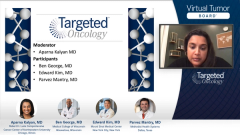
Case 3: Multidisciplinary Care in HCC Management
In the context of metastatic hepatocellular carcinoma, panelists reflect on the value of multidisciplinary care at their institutions.
Episodes in this series

Transcript:
Aparna Kalyan, MD: Before we talk about treatment, I want to get an idea from each of our panelists about your multidisciplinary clinic is run. We’re all different in terms of how we’re set up, and it’s a key point to keep in mind when we’re treating this cancer.
Edward Kim, MD:I’ll start because I had my office hours today. After office hours, I came here. It’s 1 of my favorite days of the week. We have 31 exam rooms on the 12th floor of our building. We have a large room where all the clinicians gather—it’s almost like a lounge—where we have our work stations and pack stations. Interventional radiology, hepatology, how to bill every surgery, and our transplant coordinator are all in that room. We see patients all in 1 day, and patients appreciate that. We formulate plans together, then we present all those patients because we don’t have 1 day where we see these patients on Thursday mornings in our multidisciplinary tumor board. We formulated a true multidisciplinary fashion. We navigate how many mile points a patient is. If they need transplant, they see transplant evaluation that day. For new patients either of us see, we’ll request that other physicians see them. I’ll see patients for whom I don’t think locoregional therapy is appropriate, and a surgical resection is probably better. Our surgeons and hepatologist will see patients who may require locoregional therapy, and it’s a great time. We all really enjoy that day.
Aparna Kalyan, MD:Just to clarify, Dr Kim. You’re saying that you guys don’t have a clinic together. You run through your cases, decide who’s going to be seen, and review the plan through.
Edward Kim, MD:No, have a clinic.
Aparna Kalyan, MD: You have a clinic.
Edward Kim, MD: We have 31 exam rooms. Usually I’ll see between 15 and 20 patients on a given day, and they’ll all be seen by another clinician on the same day. It’s a true clinic.
Aparna Kalyan, MD: Great. What about you, Dr George?
Ben George, MD:We start the week with neuro conference: Monday morning, 7 to 8 AM. That’s fairly heavily attended by the usual suspects. The interventional radiologists [IRs], the hepatologists, medical oncologists, radiologic oncologists, surgeons, transplant, etc. It’s a nice-looking meeting, rather than a meeting that runs through fascinomas. The downside is we look at 10 to 15 cases. They’re not all HCCs [hepatocellular carcinomas], by the way. There are cholangiocarcinomas, all kinds of liver stuff. We don’t have an integrated clinic where everyone sees the patient. With all the concerned specialties seeing the patient on 1 day. We have about 5 of us in GI [gastrointestinal] oncology. On any given day, there are at least 2 GI oncologists in the clinic. Our interventional radiologists are in the clinic maybe 3 of 5 days. Same with the surgeons. It’s not 5 days a week. We try to get them to see as many of them of the multidisciplinary providers in 1 day if possible. But often that’s not feasible. Ultimately, we have a very nice working tumor board. The discussions are extremely collaborative and collegial. We come out well from those discussions.
Aparna Kalyan, MD: Dr Mantry, how does your tumor board run?
Parvez Mantry, MD: I set up our multidisciplinary tumor board in 2008 when I moved from New York to Dallas [Texas]. It’s a special pride for me and our system because it has produced such amazing results and does such good validation by scientific studies. This is the 1 way you can improve outcomes within the treatment of HCC. We have 2 IRs. We have 2 cross-sectional imaging radiologists. We have 6 hepatologists—all our cases are presented by hepatology. We have a couple of surgeons. We have 2 medical oncologists and tumor navigators, who will arrange everything around the system. We have a big ACU [ambulatory care unit] of all 7 hospitals in our system. We present 10 to 15 cases every week and prepare dispositions on them. Then our navigator runs with the plan to the patients because we cover a very big geographical area. We have patients come from 200 to 300 miles away. Then we teach them how to do their own locoregional therapies and bring them to our center for second-line therapies or transplant.
Aparna Kalyan, MD: We’re very similar. Interestingly, our tumor board is run by interventional radiology. Dr Kim, I’m sure you know this. We recently started a multidisciplinary HCC clinic. It’s helpful because we run through the cases on a Thursday and then select patients who can be seen together on a Monday. We sort who receives new imaging, they get it done on the same day, and then get IR, hepatology, and medical oncology all in the same day. In an ideal world—I know everybody is stretched—we could have palliative care. It’s a huge component of a lot of these patients. We all struggle with this, particularly in the population that we have. But that’s the unicorn in the room, so to speak. But it’s our vision. We’ll see when we get there.
Transcript edited for clarity.












































